|
|
|
|
|
|
|
Why do so many commercial, institutional, and industrial photographers prefer to use a Better Light scanning back? Let’s face it – the need for continuous lighting, stationary subjects, and long exposure times doesn’t exactly make a scanning back “easy to use”, and the required accessories – a 4x5 camera, optics, and sturdy tripod – aren’t exactly “point and shoot”, either.
One primary reason is the superior image quality produced by the scanning back. Even the smallest Better Light model is a fifty-six megapixel capture device, with all of the advantages outlined below (see chart below photo). Whenever the subject is stationary and sufficient continuous lighting is available, a scanning back can provide the ultimate image quality obtainable today – accurate, high resolution, high dynamic range imaging.
The ability to keep using a 4x5 view camera, with unrestricted use of lens focal lengths and camera movements, is a major advantage of these systems for those making the switch to digital image capture. Architectural, commercial, and landscape photographers can keep using wide-angle lenses and camera movements to control perspective while enjoying the advantages common to all digital systems.
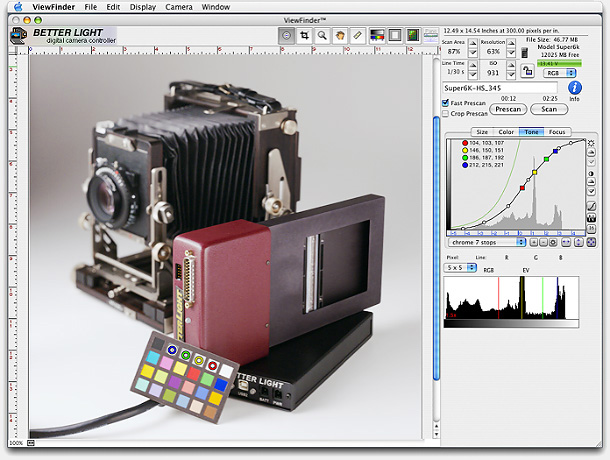
|
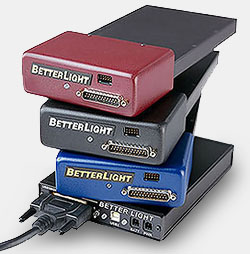 |
|
4000E-HS
|
56 megapixels
Adjustable file size up to:
53 MB (24-bit)
106 MB (48-bit)
|
6000E-HS
6000-HS
|
144 megapixels
Adjustable file size up to:
137 MB (24-bit)
274 MB (48-bit)
|
|
Super6K-HS
|
216 megapixels
Adjustable file size up to:
309 MB (24-bit)
618 MB (48-bit)
|
|
Super8K-HS
|
384 megapixels
Adjustable file size up to:
549 MB (24-bit)
1.1 GB (48-bit)
|
|
|
For more details on file sizes see FAQ
|
|
With our ViewFinder™ software you can make adjustments to image quality prior to capture,
assuring a first-generation digital image that requires very little, if any, post-production corrections.
|
|
|
Precise control of exposure and image tone is another reason professionals prefer Better Light – our ViewFinder™ software shows both “raw” and “output” histograms, with one-tenth f-stop control of ISO sensitivity and one-third f-stop control of exposure time for easy adjustment to the exact image desired, whether measuring digital pixel values or simply observing the displayed prescan image. Interactive controls update the existing prescan image data and display to accurately show the effects of adjustments without requiring another prescan.
By this time, it’s fairly widely acknowledged that a scanning back can produce image quality superior to 4x5 film, and often superior to 8x10 film, although the mechanisms behind this observation are not always understood. Scanning backs also can produce image quality superior to any other digital camera technology available today, a situation unchanged since the introduction of Better Light’s first-generation scanning backs by Dicomed in 1994. This document will explore why a Better Light scanning back is able to deliver this high level of image quality by comparing the primary performance metrics with other digital camera technologies, and by extrapolating these performance metrics to compare image quality with film: SPATIAL RESOLUTION, DYNAMIC RANGE, NOISE / CLARITY and COLOR ACCURACY.
|

|
|
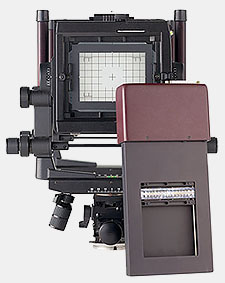 SPATIAL RESOLUTION SPATIAL RESOLUTION
Scanning backs have a definite advantage here, and not just in their huge numbers of pixels. The large imaging area (scan area) of these devices means that they can deliver huge numbers of fairly large pixels, and larger pixels don’t demand as much of the camera optics as small pixels would. This means that not only does one get more pixels of information from a scanning back, but also that each pixel is more distinct (more sharply defined) from its neighbors than a sensor with smaller pixels could obtain. Sharpness and contrast are the primary components of spatial resolution, and large numbers of large pixels nearly always have the edge (pardon the bad pun).
Scanning backs also capture true red, green, and blue pixel information at every pixel site, so they don’t require the interpolation common to other digital cameras, thus providing almost twice the optical resolution for the same number of pixel sites. Furthermore, capturing full color at every pixel site eliminates the color interpolation and artifact suppression filtering common to other digital cameras, thereby providing much higher color purity as well as more subtle color gradations at every pixel site, for improved spatial (color) resolution.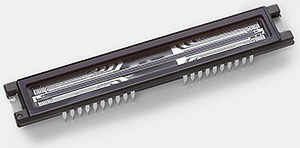
In absolute terms, a scanning back with the 6000-pixel Kodak CCD has 12 micron (.012 mm) pixels, so this sensor will have a resolution limit of 41 line pairs per millimeter with better than 60 percent contrast. Models with the 8000-pixel Kodak CCD have 9 micron pixels with a resolution limit of 55 line pairs per millimeter with better than 60 percent contrast. These values meet or exceed those of large-format film, although film can achieve resolution of up to 80 line pairs per millimeter with just-detectable contrast under laboratory conditions. However, real-world conditions – in other words, when using a lens – seldom yield anywhere near this performance from film, while the scanning back’s somewhat lower limiting resolution is still a good match for these optics. Unlike sheet film in a typical film holder, the scanning back’s CCD travels in an absolutely flat plane across the image area, and the sensor itself can be used to indicate absolute focus quality anywhere in the image area with the lens at working aperture, eliminating all sources of potential focus error for optimum results every time.
|
|
Another factor affecting spatial resolution is the noise level of the image – higher noise levels will obscure small details behind a veil of random information, whether digital noise or film grain. The high dynamic range of Better Light scanning backs delivers low-noise images where the smallest detail – each individual pixel – is clearly and accurately captured in true color. Film grain has a huge influence on the small-detail resolution of film, as attested to by the standard practice of using long parallel lines to measure resolution. Although the random density of film grain obscures portions of these lines at higher resolutions, the overall presence of a line can still be determined from the remaining portions. This practice of using parallel lines improves film’s performance on resolution tests, but not when trying to read the 4-point type on a photograph of a large map.
|
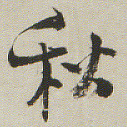
|
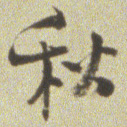 |
|
Close-up detail of Chinese scroll capturedwith Better Light scanning back.
|
Close-up detail of same Chinese scroll scanned from transparency film. |
|

|
|
DYNAMIC RANGE
Probably one of the most misunderstood terms in digital imaging, if only because there are so many different definitions of the term. The PRACTICAL you-can-use-this definition for image capture dynamic range should be the number of f-stops between the highest discernable light level and the lowest discernable light level above a minimum acceptable image quality. The “minimum acceptable image quality” term keeps things reasonable by requiring a minimum signal-to-noise ratio for the dark end of the image, since it’s difficult to use image data that’s too noisy, even if you can still see some differences in the noise.
This definition is more stringent than simply defining “dynamic range” by the number of bits in the data converter, as other digital camera vendors often do. This definition is also more stringent than defining “dynamic range” as the number of f-stops between the image sensor’s maximum (saturation) exposure and its background noise in darkness, as sensor vendors often do. By requiring a minimum signal-to-noise ratio, the real-world effects of image sensor full-well capacity, dark current, and other performance factors are included in the determination of dynamic range, for more accurate and realistic results.
Because of their large full-well capacity and immediate pixel readout for each line, Kodak’s trilinear image sensors provide impressive dynamic range capabilities, with over eleven f-stops of range between the highest discernable level and the lowest discernable level above a minimum signal-to-noise ratio of 10-to-1. A signal-to-noise ratio of 10-to-1 is often considered the minimum for “acceptable” image quality, although this usually refers to the overall image, and not just to the darker shadow regions. Therefore, this method of determining dynamic range would be considered quite conservative, but more realistic.
Like other digital capture devices, the scanning back’s dynamic range is not constant, but varies with the exposure settings. The system will have less dynamic range under lower-light exposure conditions, when either or both of the exposure time and/or ISO sensitivity must be increased to compensate for insufficient light. However, a scanning back can still have as much dynamic range under marginal exposure conditions – about six f-stops – as many smaller digital cameras have under optimum conditions.
Reversal films have a relatively fixed dynamic range – their ability to capture a range of scene brightness levels is limited to about seven f-stops, even though the film itself will have considerably more contrast. Negative films are just the opposite, capable of recording over 9 f-stops of scene brightness into a low-contrast negative original. Higher ISO sensitivity films (reversal or negative) tend to have higher contrast and more pronounced film grain, with correspondingly less usable dynamic range.
|

|
|
NOISE / CLARITY
Noise in the shadows of an image may reduce its dynamic range, but noise anywhere in an image will affect its clarity – how pure the smooth areas of the image appear, and how clearly the detailed areas of the image are perceived. Limited clarity is one of the biggest shortcomings of film, brought about by the ever-present film grain. Improved clarity, more than improved resolution, is one of the primary reasons for shooting large-format film, since larger film sizes require less magnification for a given print size, and therefore don’t show film grain as much as smaller formats requiring higher magnification.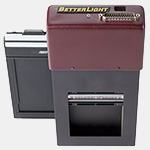
Improved clarity is also one of the reasons why most observers agree that a scanning back produces better image quality than large-format film. Even if the actual spatial resolution between 4x5 film and a scanning back is similar, the scanning back will have MUCH lower noise (much higher clarity) overall, making its image appear like one from a much larger film format, especially at larger print sizes.
Clarity is not measured directly, but its reciprocal, image noise, can be measured or calculated from other parameters. Based on both spreadsheet calculations and actual image measurements, a Better Light scanning back can have as little as 0.3% RMS noise in the upper midtones of an image (like blue sky). This excellent performance is due primarily to the outstanding signal-to-noise ratio of the scanning back, which in turn is due to the large full-well capacity of its Kodak trilinear image sensor.
Film vendors measure “noise” (film grain) as “diffuse RMS granularity” with a standard procedure that uses a relatively large aperture (48 microns) to measure the density changes within an otherwise uniformly-exposed (upper midtone) area of the film. The RMS (Root Mean Square – approximately the average) value of these large-aperture density changes gets expressed as the “diffuse RMS granularity”. Low-ISO, fine-grained films might have a diffuse RMS granularity of 8, which calculates to an RMS noise level of about 1.8% when using a 48 micron aperture. However, a 48 micron aperture only allows for 2,000 by 2,500 distinct pixels when scanning 4x5 film, which would only produce a print of 13.3 by 16.7 inches at 150 pixels per inch.
Decreasing the scanning aperture to increase the scanned resolution also increases the RMS granularity (noise) of a film image. For example, if one desires to make a 30 x 40 inch print at 150 pixels per inch, 4x5 film would need to be scanned with a 20 micron aperture to produce 4,500 by 6,000 pixels. This smaller aperture will increase the RMS noise to about 3.9% in the upper midtones, which would be clearly visible in most images.
By comparison, a 6,000 by 8,000 pixel image from a Better Light scanning back can make a print 40 by 53 inches in size at 150 pixels per inch with as little as 0.3% RMS noise – almost twice the print size, with ten times lower noise.
|

|
|
COLOR ACCURACY
Spatial resolution, dynamic range, and clarity are generally panchromatic characteristics of an image capture device. Color accuracy characterizes the color response of the device, and includes several items – how accurately an image capture device can maintain an absolutely neutral gray scale from black to white, how accurately the device can record a wide gamut of different colors, and how accurately the device can differentiate subtle differences among similar colors. Not surprisingly, a scanning back has significantly better color accuracy than either film or other digital camera technologies.
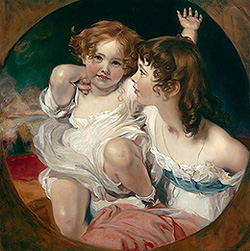 Modern color films are miracles of chemistry and color science, with the ability to perform local color masking, contrast enhancement, and other image processing tricks built right into the film. These complex chemical interactions have been developed (another bad pun) to compensate for some of the shortcomings of film, especially regarding its color accuracy. Most color films are designed to produce “pleasing color” more than “accurate color”, and the current popularity of richly saturated, larger-than-life color films suggests that this is what most consumers want. Unless, of course, one is photographing a magnificent museum artifact for posterity, or scanning an artist’s original work for high-quality reproduction, where absolutely unbiased color accuracy is essential. Modern color films are miracles of chemistry and color science, with the ability to perform local color masking, contrast enhancement, and other image processing tricks built right into the film. These complex chemical interactions have been developed (another bad pun) to compensate for some of the shortcomings of film, especially regarding its color accuracy. Most color films are designed to produce “pleasing color” more than “accurate color”, and the current popularity of richly saturated, larger-than-life color films suggests that this is what most consumers want. Unless, of course, one is photographing a magnificent museum artifact for posterity, or scanning an artist’s original work for high-quality reproduction, where absolutely unbiased color accuracy is essential.
Other digital camera technologies with RGB color filter patterns on the sensor (often a Bayer pattern for instant-capture devices) must use interpolation to reconstruct the proper color of each pixel in the image. This glorified guessing game, and the obvious color artifacts so often produced by its decisions, have led most camera vendors to “dumb down” the color response of these devices in regions of fine detail to help suppress these artifacts, leading to inaccurate color response in these regions. Furthermore, most instant-capture systems over-emphasize colors in smooth regions of the image, perhaps following the call of the popular larger-than-life color films. In many cases, the photographer has no control over these manipulations, just as was the case with film.
Instant-capture devices utilizing an RGB color filter pattern on the sensor have another shortcoming – it is very difficult to precisely align the pattern of color filters with the actual pixel boundaries on the sensor, and any misalignment of the color filters means that each pixel will respond to more than one color, in direct proportion to any misalignment. Many such image sensors specify a “color purity” error of as much as 20% across the sensor, which is caused primarily by misalignment of the color filter pattern. These significant color errors must be corrected via software after each capture, leading to further compromises in the color accuracy of the device. Multi-shot image capture devices may be able to avoid interpolation artifacts by moving the sensor between exposures until a full-color image has been recorded, but these devices still have color filter pattern misalignment errors to deal with.
Scanning backs have none of the above shortcomings – each row of pixels is covered with the same color filter, and the other rows (with other color filters) are relatively far away, so it’s easier to apply a uniform, single-color filter to each row. Every pixel in the image is captured with pure red, green, and blue information, so there are no interpolation artifacts, and no image processing to avoid them. Furthermore, because each color plane of the image is captured with the same row of pixels as the sensor scans, there are no spatial color purity issues to worry about – uniform response is assured across the entire image.
Some of the color accuracy advantage of a Better Light scanning back is probably due to the straightforward design of these devices. Unlike film or other digital cameras that must compensate for a variety of color reproduction shortcomings by manipulating their color response, a Better Light scanning back treats each color channel as a completely independent monochrome image, with absolutely no interaction among the three color signals at any point in the capture process. This is as close to a pure RGB separation as one can get, and while the color response of the Kodak sensors isn’t perfect, the pure, unmanipulated color data from a Better Light system can be profiled and corrected more accurately than image data from other capture devices.
|
|
|
|
|
|
|
|
|

